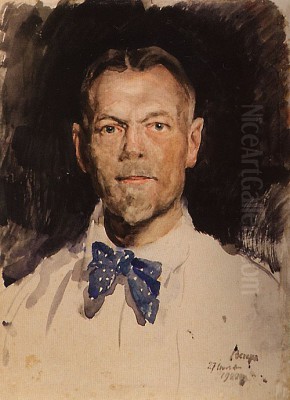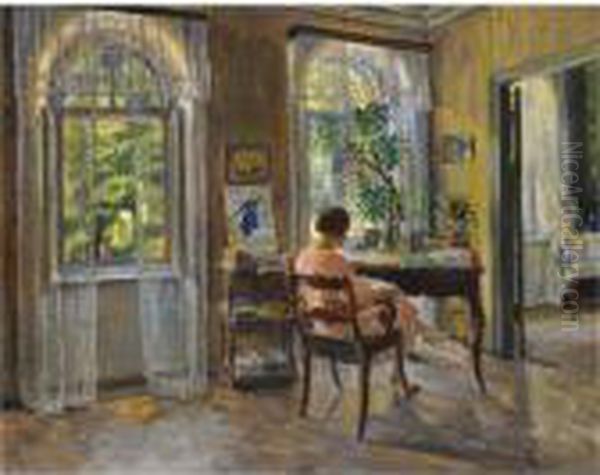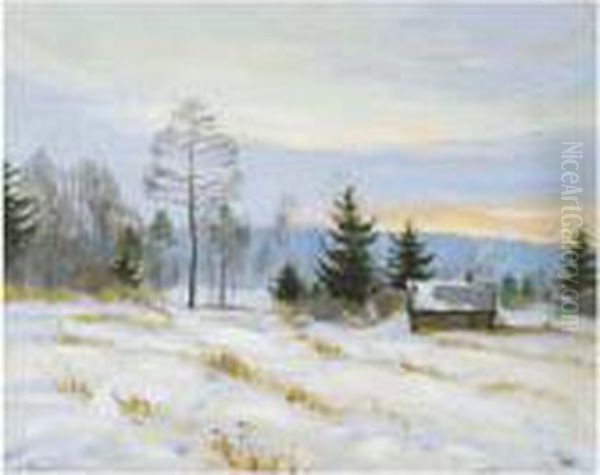
Sergey Arsenievich Vinogradov stands as a significant, if sometimes underappreciated, figure in the rich tapestry of Russian art at the turn of the 20th century. A dedicated practitioner of Impressionism, he captured the fleeting beauty of the Russian landscape, the quiet intimacy of domestic interiors, and the vibrant character of its people with a distinctive warmth and lyrical sensitivity. His life and career spanned a period of immense artistic and social upheaval, yet his work largely remained a testament to the enduring allure of light, color, and the simple graces of life.
Early Life and Artistic Awakening
Sergey Arsenievich Vinogradov was born on July 1 (Julian calendar; July 13 Gregorian), 1869, in the village of Bolshie Soli, nestled in the Kostroma Governorate of the Russian Empire (now Nekrasovskoye, Yaroslavl Oblast). His father, Arseny Vinogradov, was a village priest, a background that perhaps instilled in the young Sergey a deep connection to the rhythms of rural life and the spiritual undercurrents of the Russian land. This connection would later manifest profoundly in his landscape and genre paintings.
From an early age, Vinogradov displayed a natural inclination towards drawing and painting. The provincial setting, with its traditional wooden architecture, expansive fields, and the changing seasons, provided ample inspiration. While detailed records of his earliest artistic endeavors are scarce, it is evident that his passion was strong enough to pursue formal artistic training, a significant step for someone from a rural clerical family at that time.
Formal Artistic Education: Moscow and Saint Petersburg
In 1880, at the age of eleven, Vinogradov embarked on his formal artistic journey, enrolling in the prestigious Moscow School of Painting, Sculpture, and Architecture (MUZHVZ). This institution was a crucible of artistic talent and a vital center for the development of Russian art, fostering both traditional academicism and emerging realist and nationalist trends. During his nine years at MUZHVZ, until 1889, Vinogradov studied under some of the most influential Russian artists of the era.

His teachers included Illarion Pryanishnikov, a prominent member of the Peredvizhniki (the Wanderers) known for his poignant genre scenes. Vladimir Makovsky, another leading Peredvizhnik, also imparted his skills in capturing everyday Russian life. Perhaps most significantly, Vinogradov studied under Vasily Polenov. Polenov, himself a master of landscape and genre painting, was increasingly influenced by Impressionist techniques, particularly in his treatment of light and plein air painting. His mentorship was crucial in shaping Vinogradov's burgeoning interest in capturing atmospheric effects and the nuances of natural light. Other towering figures like Ilya Repin and Isaac Levitan were also associated with MUZHVZ during this period, contributing to the rich artistic environment that Vinogradov absorbed.
Upon completing his studies in Moscow, Vinogradov sought to further refine his skills at the Imperial Academy of Arts in Saint Petersburg. He attended the Academy from 1889, studying under noted battle painter Bogdan Willewalde and Carl Wenig. While the Academy was traditionally more conservative than MUZHVZ, Vinogradov's time there would have exposed him to a different facet of the Russian art establishment and further honed his technical proficiency. In 1888, even before formally finishing all his studies, he had earned the title of "artist," a testament to his recognized talent.
The Emergence of an Impressionist Voice
The 1890s marked the true beginning of Vinogradov's independent artistic career and the consolidation of his Impressionist style. While his early works bore the influence of the Peredvizhniki's realism, particularly in their subject matter drawn from peasant life and the Russian countryside, his approach to light and color increasingly diverged towards a more Impressionistic sensibility.
He was deeply influenced by the French Impressionists, whose works were becoming known in Russia through exhibitions and private collections. However, Vinogradov, like his contemporary Konstantin Korovin and others such as Valentin Serov and Igor Grabar, developed a distinctly Russian variant of Impressionism. This style was less about the scientific deconstruction of light and more focused on conveying an emotional, lyrical response to the subject, often imbued with a sense of poetic melancholy or gentle joy.
Vinogradov's Impressionism was characterized by a vibrant palette, broken brushwork, and a keen attention to the play of light and shadow. He excelled at capturing the fleeting moments of the day – the dappled sunlight filtering through leaves, the soft glow of a lamp in an interior, or the hazy atmosphere of a summer afternoon. His canvases often exude a feeling of warmth, serenity, and an intimate connection with the world he depicted.
Key Themes and Subjects in Vinogradov's Art
Throughout his career, Vinogradov explored several recurring themes, each rendered with his characteristic Impressionistic flair.

Landscapes: The Russian landscape was a central and enduring passion. He painted sun-drenched summer days, the golden hues of autumn, and the crisp, clear light of winter. His landscapes often feature rural settings, country estates, and river scenes. He had a particular fondness for depicting the effects of sunlight on water and foliage, creating scenes that shimmer with life and atmosphere. Works like "Country Road" exemplify his ability to transform a simple scene into a poetic meditation on nature.
Genre Scenes: Drawing from his early influences and his deep understanding of Russian rural life, Vinogradov created numerous genre paintings. These often depicted peasants at work or leisure, children playing, or quiet moments of village life. Unlike some of the more critical social realism of the Peredvizhniki, Vinogradov's genre scenes, while realistic in their observation, often emphasized the picturesque and harmonious aspects of rural existence. "Boys by the River" (also known as "Down the River Boys"), painted in 1898, is a prime example, capturing a moment of youthful insouciance with a vibrant, sunlit palette.
Interiors: Vinogradov was also a master of the interior scene. He often painted rooms in manor houses or his own living spaces, focusing on the interplay of light streaming through windows, illuminating furniture, figures, and everyday objects. These interiors are rarely just architectural studies; they are imbued with a sense of human presence and the quiet poetry of domestic life. His 1914 painting, "The House," is a celebrated example, showcasing his skill in rendering complex light effects and creating an atmosphere of tranquil domesticity. Other works simply titled "Interior" or featuring peasant women in their homes further highlight this thematic interest.
Notable Works: A Closer Look
Several of Vinogradov's paintings stand out as particularly representative of his style and artistic achievements.
"Boys by the River" (1898): This iconic work, housed in the State Russian Museum, captures a group of peasant boys on the bank of a river, likely preparing for a swim or engaged in playful activity. The painting is bathed in bright sunlight, with dazzling reflections on the water and a vibrant depiction of the lush summer foliage. Vinogradov's loose brushwork and rich color palette convey the energy and warmth of the scene, making it a quintessential example of Russian Impressionist genre painting.
"The House" (1914): This painting, featured on a commemorative Russian postage stamp in 2019 alongside a self-portrait of the artist, depicts a sunlit interior, possibly a room in a country estate. Light floods in from a window, illuminating a table set for tea and casting intricate shadows. The work is a masterful study of light and atmosphere, creating a sense of peace and refined comfort. The careful arrangement of objects and the subtle gradations of color showcase Vinogradov's mature Impressionistic technique.
"Country Road": While specific dates for all works titled "Country Road" may vary, this theme was recurrent. These paintings typically depict a sun-dappled path winding through fields or woods, often with figures or a horse-drawn cart. They evoke the tranquility and timeless beauty of the Russian countryside, rendered with Vinogradov's characteristic attention to atmospheric effects and the play of light.
Other significant works include various landscapes depicting different seasons, portraits such as his "Self-Portrait" and depictions of "Peasant Woman," and numerous other intimate "Interior" scenes. His work "Shepherd" also reflects his engagement with rural themes.
The Union of Russian Artists and Exhibitions
Sergey Vinogradov was not an isolated artist but an active participant in the vibrant art world of his time. He initially exhibited with the Peredvizhniki, starting in 1898. This association connected him with the leading realist painters of Russia and provided a platform for his early works.
However, as his style evolved more decisively towards Impressionism, his affiliations shifted. In 1903, Vinogradov became one of the founding members of the Union of Russian Artists (Soyuz Russkikh Khudozhnikov). This influential exhibiting society brought together many artists who, while diverse in their individual styles, shared a common interest in developing a modern Russian art that was distinct from both academic conservatism and the more overtly narrative or critical tendencies of the later Peredvizhniki.
The Union of Russian Artists became a major force in the Russian art scene, organizing regular exhibitions in Moscow and Saint Petersburg. Its members included prominent figures like Konstantin Korovin, Valentin Serov, Abram Arkhipov, Stanislav Zhukovsky, Leonard Turzhansky, Konstantin Yuon, Mikhail Nesterov, and Igor Grabar. Vinogradov was an active and respected member of this group, regularly contributing his lyrical landscapes and genre scenes to their exhibitions. His involvement with the Union solidified his position as a key figure in the Russian Impressionist movement.
Vinogradov's work also gained international recognition. He participated in numerous exhibitions abroad, including shows in Paris, Dusseldorf, Berlin, Munich, Prague, and even New York. This exposure helped to introduce Russian Impressionism to a wider audience and demonstrated the vitality of modern art in Russia.
Teaching and Influence
Beyond his own creative output, Sergey Vinogradov made significant contributions as an art educator. He taught for many years at the Stroganov Central Industrial Art School in Moscow (now the Stroganov Moscow State Academy of Arts and Industry). His colleague and friend, Konstantin Korovin, also taught there, and together they influenced a generation of younger artists.
Vinogradov was known as a dedicated and inspiring teacher. His own mastery of Impressionist techniques, particularly his understanding of color and light, would have been invaluable to his students. He encouraged them to observe nature closely and to develop their own individual artistic voices.
During the First World War, Vinogradov, like many artists, turned his attention to subjects related to the conflict, including creating military scenes and poster designs. This period marked a temporary shift in his thematic focus, reflecting the broader societal concerns of the time.
Later Years, Emigration, and Legacy in Riga
The Russian Revolution of 1917 and the subsequent Civil War brought profound changes to Russian society and its art world. While some artists embraced the new Soviet regime and its artistic doctrines, others found themselves increasingly out of step with the prevailing trends.
In the aftermath of the Revolution, likely in the early 1920s, Vinogradov made the decision to emigrate. He settled in Riga, the capital of newly independent Latvia. This move marked a new chapter in his life and career. In Riga, he continued to paint and remained active as an artist and teacher. He opened his own private art school, where he nurtured local talent and continued to propagate the principles of Impressionist painting.
His work from this period often reflects his new surroundings, though he continued to draw upon the themes and stylistic approaches that had defined his earlier career. The Latvian landscapes and cityscapes provided fresh inspiration, but the underlying lyricism and focus on light remained consistent.
Sergey Arsenievich Vinogradov passed away in Riga on February 5, 1938, at the age of 68, reportedly from pneumonia. He was buried in the Pokrovskoe Cemetery in Riga. He left behind a significant body of work that continues to be admired for its beauty, technical skill, and heartfelt depiction of Russian life and nature.
He also reportedly wrote memoirs about the pre-revolutionary Russian art world, which, if extensively preserved, would offer invaluable insights into the artistic milieu he inhabited.
Collections and Enduring Recognition
Today, Sergey Vinogradov's paintings are held in numerous prestigious museums and private collections, primarily in Russia and the countries of the former Soviet Union. The State Tretyakov Gallery in Moscow holds a significant collection of his works, including key pieces like "Shepherd," "Self-Portrait," "Peasant Woman," and various "Interior" scenes. The State Russian Museum in Saint Petersburg is home to his celebrated "Boys by the River."
His works can also be found in other important institutions such as the Tver Regional Art Gallery and the Sakha Republic National Art Museum (Yakutia). While one source mentions the Avignon Museum of Modern Art, this is less typical for Russian Impressionists and would warrant further verification for specific holdings. The presence of his works in regional Russian museums underscores his national importance.
The enduring appeal of Vinogradov's art was recognized in 2019 when the Russian Post issued a commemorative postage stamp featuring his self-portrait and his painting "The House" to mark the 150th anniversary of his birth. This act signifies his lasting place in the canon of Russian art.
Conclusion: A Luminous Vision
Sergey Arsenievich Vinogradov was a dedicated and gifted painter whose art provides a luminous window into the world of late Tsarist and early 20th-century Russia. As a prominent member of the Russian Impressionist movement and a co-founder of the influential Union of Russian Artists, he played a vital role in shaping the artistic landscape of his time.
His paintings, characterized by their vibrant color, masterful handling of light, and lyrical sensitivity, capture the ephemeral beauty of the Russian countryside, the intimate charm of domestic interiors, and the quiet dignity of everyday life. From his formative years under the guidance of masters like Vasily Polenov to his mature career as an established artist and teacher, and finally to his later years in Riga, Vinogradov remained true to his artistic vision. He sought to convey not just the visual appearance of his subjects, but also the emotional resonance and poetic atmosphere they evoked. His legacy endures in his beautiful canvases, which continue to delight viewers with their warmth, sincerity, and timeless appeal, securing his place as a cherished chronicler of Russian Impressionism.